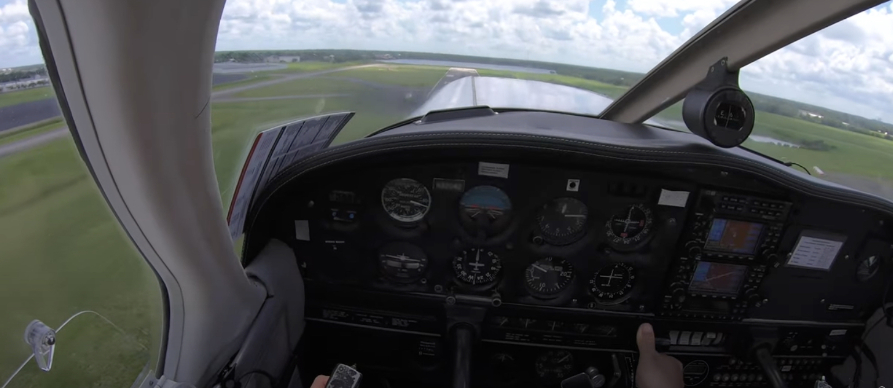
All pilots operating an East Coast Aero Club aircraft are required to use and adhere to the current published checklist for each aircraft make and model, for all aspects and phases of every flight.
Prior to any takeoff, all pilots are required to complete all run-up checks to ensure the airplane and all required crew are suitably prepared for the flight.
Within the checklist “Takeoff Brief” section, there is a checklist item “Takeoff briefing”.
Prior to the checklist item being marked as complete the pilot is required to:
- Brief the takeoff
- The brief will provide a summary of the conditions of the takeoff and the intentions of the flight (i.e staying in the traffic pattern, or departing the airport environment)
- The brief will also include conditions of any take off abort situations
- Brief actions in the event the failure of the powerplant and loss of required engine power in four stages of the take off phase.
- Loss of engine power – before rotation airplane still on the runway
- Loss of engine after rotation with runway remaining ahead
- Loss of engine after rotation with no runway remaining below 1000’ AGL Loss of engine after rotation with no runway remaining above 1000’ AGL
- Clearly establish who the Pilot in Command is, in event of engine power loss.
In the event of any emergency it is important to note:
FAR §91.3 Responsibility and authority of the pilot in command.
(a) The pilot in command of an aircraft is directly responsible for, and is the final authority as to, the operation of that aircraft.
(b) In an in-flight emergency requiring immediate action, the pilot in command may deviate from any rule of this part to the extent required to meet that emergency.
The Takeoff briefing is not complete until these two items have been completed.
Takeoff Briefing
Takeoff Briefing is to include:
- Runway (name and check the runway intended to be use for for takeoff
- Runway length (State the runway length in feet)
- Weather Conditions
- Wind speed and direction (Headwind / Cross Wind / Tailwind)
- Cloud Bases
- Precipitin
- Turbulence / Wake Turbulence
- Expected Obstacles
- Takeoff Type
- Normal Takeoff
- Crosswind Takeoff
- Short Field Takeoff
- Soft Field Takeoff
- Airplane Configuration
- Flaps
- Power
- Intentions (to include – but not limited to)
- Stay in Traffic Pattern (for stop and go’s or touch and go’s)
- Depart Airport Environment to the (direction)
- Other
- Take off actions (REACT)
- RPM – Full Power (know and brief static RPM)
- Engine Gauges (All green)
- Airspeed Indicator (showing airspeed call out “Airspeed alive”)
- Centerline (accelerate and remain on the centerline)
- Takeoff / Abort Point
- Rotate at ____ kias / climb at ____ kias Vx / Vy
- Abort take off if we haven’t rotate by _______ defined point
- Fly the runway heading until ______ feet AGL
- Traffic Pattern Altitude is _______ feet MSL
Engine Power loss during takeoff briefing
It is essential that for each flight, the actions in case of the loss of engine power should occur during the takeoff phases of the flight be briefed before takeoff. This establishes the actions to be carried out in the event of a power loss (for each phase) and to ensure that all occupants of the aircraft understand these actions and establish who the pilot in command is and required actions by the other pilot in the event of the loss of power.
Engine Power loss on takeoff briefing to include:
- Loss of engine – airplane still on the runway
- Loss of engine after rotation with runway remaining ahead
- Loss of engine after rotation with no runway remaining below 1000’ AGL
- Loss of engine after rotation with no runway remaining above 1000’ AGL
- Pilot in Command in event of engine power loss
Loss of engine – airplane still on the runway
In the event of losing power (or any other indication that takeoff is unsafe) while still on the runway
- Reduce Power (if applicable)
- Apply breaking
- Safely bring the aircraft to a complete stop
- Make radio call as applicable
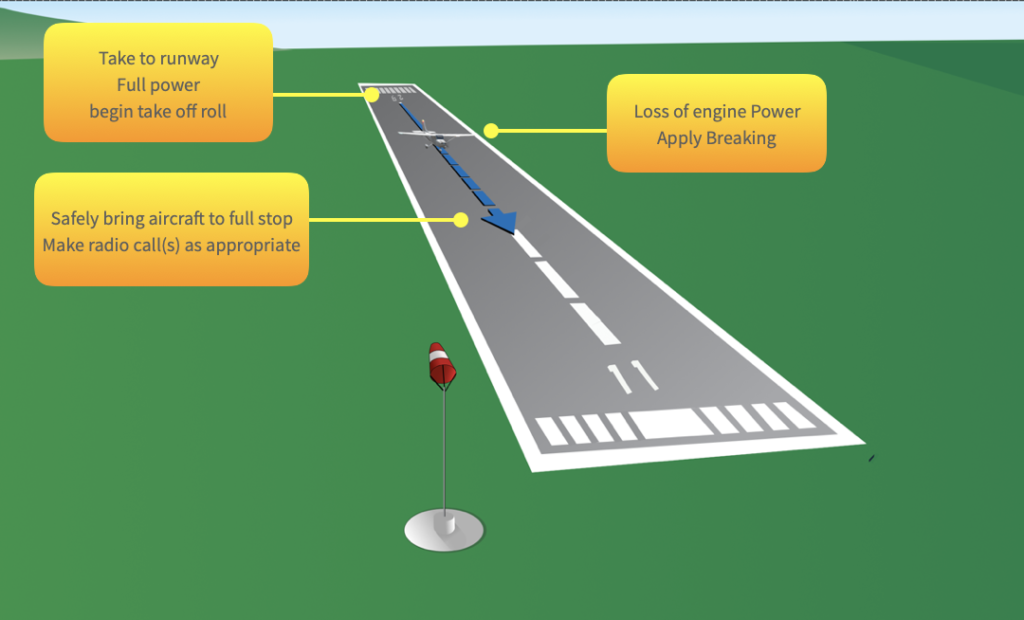
The critical action is recognize the loss of power and to apply adequate breaking action to keep the aircraft on the centerline and safely bring the aircraft to a stop under control. Aileron input maybe needed to counteract crosswind drift.
Once the emergency has been dealt with, make radio calls as appropriate to alert ATC / other airport traffic to the situation.
Loss of engine power – after rotating and takeoff – runway remaining ahead
In the event of losing power while still on the runway
- Pitch for airspeed (best glide – don’t stall the aircraft!!)
- Safely land back onto the runway surface
- Apply breaking
- Safely bring the aircraft to a complete stop
- Make radio call(s) as applicable
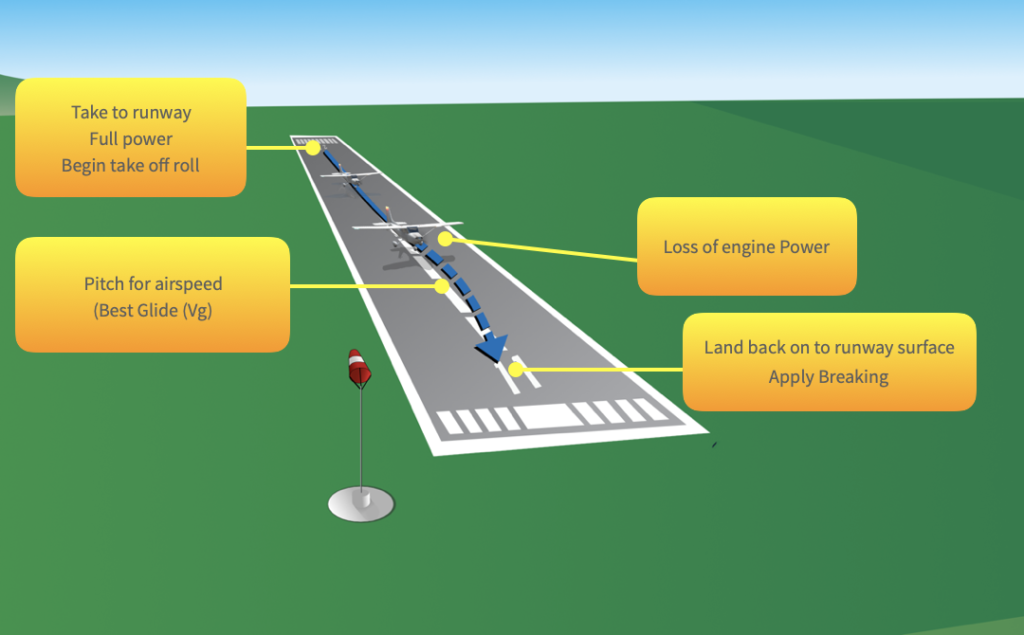
The critical action is to recognize the loss of power and to transition the airplane from a nose high, climb attitude to a pitch attitude that will prevent a stall and possible spin to the left.
The airplane should be pitched for adequate an airspeed above the stall speed for the current configuration of the airplane.
The airplane should be pitched for landing using flaps as appropriate to land the airplane on the runway surface.
Once the airplane has been landed, adequate breaking action is required to safely bring the aircraft to a stop under control. Once the airplane has been brought to a full stop and the immediate emergency has been dealt with, make radio calls as appropriate to alert ATC / other airport traffic to the situation.
Loss of engine power after takeoff – no runway remaining, altitude is below 1000’ AGL
In the event of losing engine power after taking off – no runway ahead and below 1000’ AGL
- Pitch for airspeed (best glide – don’t stall the aircraft!!)
- Locate a safe place ahead to land.
- Make shallow turns of no more than 30° of bank
- If time allows, begin checklist, attempt restart of engine, declare – make radio calls to ATC / 121.5
- Land airplane on appropriate / chosen landing area.
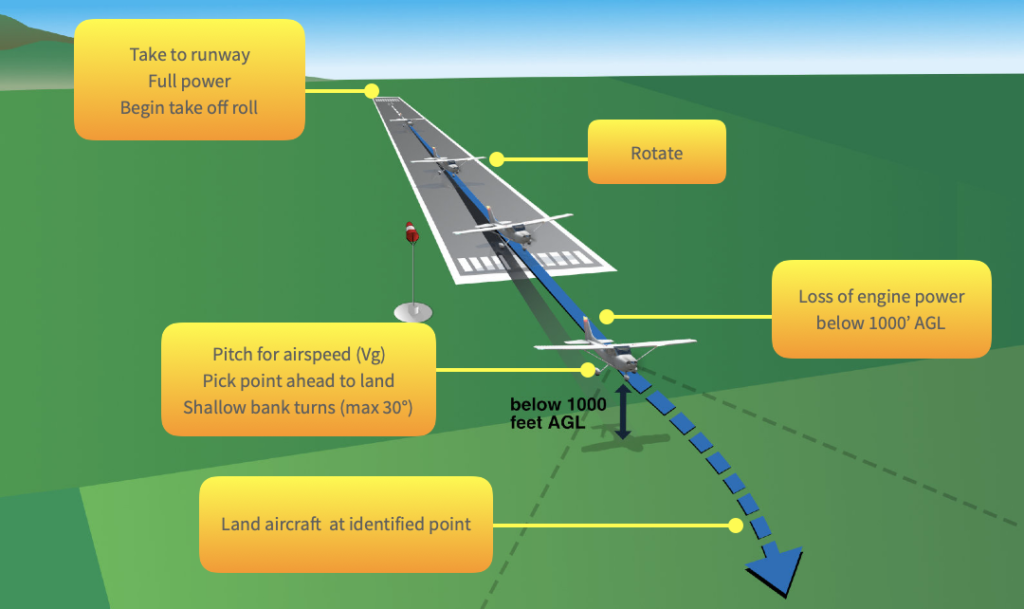
The critical action is recognize the loss of power quickly and to transition the airplane from a nose high, climb attitude to a best glide pitch attitude. Best glide speed will provided the most distance (and time) available to land the airplane. Anything faster or slower than best glide speed will decrease the time and distance available to fly the plane to the landing point. It is critical that there is no attempt to stretch the glide by raising the nose. This will slow the aircraft down to the stall speed and increase the possibility of stall and the possibility of a spin.
Once the airplane airspeed has been established for best glide, an appropriate spot to land must be identified. Care should be taken to prevent causing harm or injury to people on the ground.
Shallow turns (under 30° of bank) can be made to fly and navigate to an appropriate landing spot. A narrow field of landing should be adhered to (shown in diagram) in identifying a landing spot.
If time permits, attempt to re-start the engine, declare (7700, mayday calls, ELT) and prepare the airplane for an emergency landing. Use flaps as appropriate to land the airplane in a safe spot. Once the airplane has been landed, use breaks to safely bring the aircraft to a stop under control.
Loss of engine power after takeoff – no runway remaining, altitude is above 1000’ AGL
In the event of losing engine power after taking off – no runway ahead and above 1000’ AGL
- Pitch for airspeed (best glide – don’t stall the aircraft!!)
- Identify altitude and location in relation to airport.
- If position permits begin turn back to the airport
- If time allows begin checklist, attempt restart of engine, declare – make radio calls to ATC / 121.5
- Land airplane on appropriate spot.
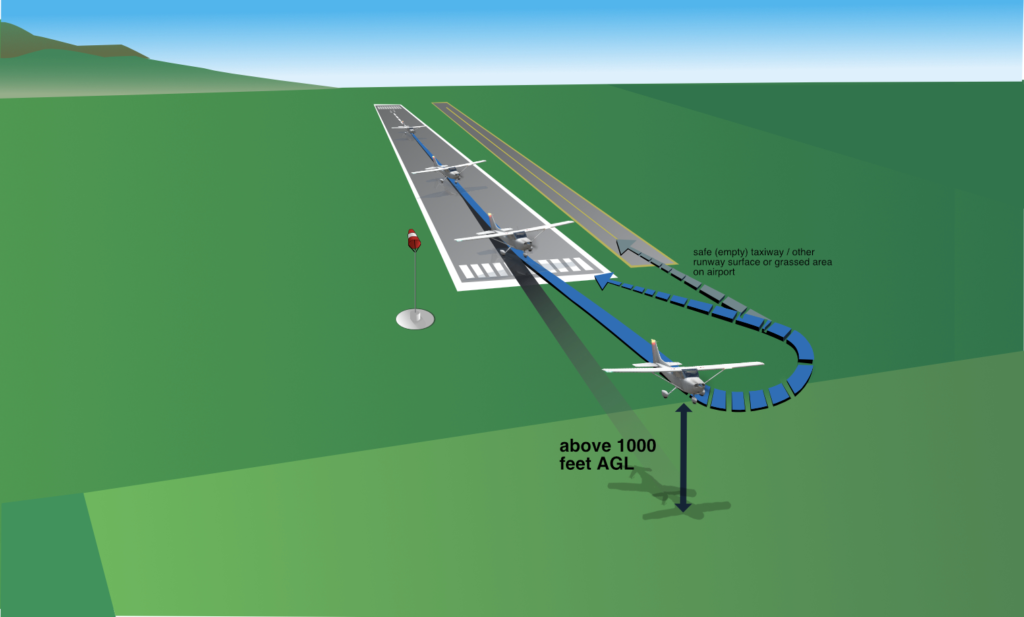
he critical action is recognize the loss of power quickly and to transition the airplane from a nose high, climb attitude to a best glide pitch attitude. Best glide speed will provided the most distance (and time) available and best possible chance to turn back to the airport (if you are in the vicinity) to land the airplane. Anything faster or slower than best glide speed will decrease the time and distance available to fly the plane to the landing point. It is critical that there is no attempt to stretch the glide by raising the nose. This will slow the aircraft down to the stall speed and increase the possibility of stall and the possibility of a spin.
If a turn back is possible, begin the turn immediately, don’t fly away from the runway any more than you need to. Steep turns should be avoided while navigating to an appropriate landing spot.
If time permits, attempt to re-start the engine, declare (7700, mayday calls ATC / 121.5, ELT) and prepare the airplane for an emergency landing. Use flaps as appropriate to land the airplane and aim for a runway surface or other safe spot. Once the airplane has been landed, use breaking to safely bring the aircraft to a complete stop under control.
The “impossible turn”
A low altitude power loss is a time-critical emergency, especially on departure. Unless you’ve thoroughly planned an emergency landing point for departure (which you should do), the surprise of the engine failure will leave you with few landing options.
Your initial reaction may be to return to the runway, which under some circumstances is acceptable.
But more often than not, your safest option is to land somewhere straight ahead of you.
Returning To The Runway? Keep These Hazards In Mind
- You probably don’t have enough altitude to be able to turn the aircraft and glide back to the airport. You will be descending from the time you lose your engine. You simply may not be able to safely make this turn with altitude you have available.
- You probably took off with a headwind. If you make a return to the runway, you’ll now be faced with a tailwind, which increases your groundspeed and rushes your ability to fly a safe approach and stop on the runway. There’s not a lot of margin for error with a strong tailwind.
- The increasing groundspeed due to the tailwind could lead you to prematurely slowing the aircraft below stall speed. With no altitude to trade for airspeed.
- As your airplane loses altitude during the turn, it’s possible you could contact the ground in a bank. This could result in your aircraft cartwheeling across the ground…not an ideal outcome.
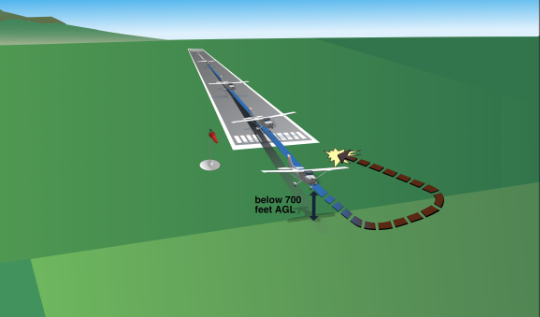
You should always have a plan for engine failure on takeoff. During your takeoff briefing, include a go / no-go point for the “impossible turn.” If in doubt its usually better to pick a landing point ahead of you, rather than the runway behind you. Take into account wind, altitude, aircraft performance, glide distance, and personal experience and comfort before making the decision.